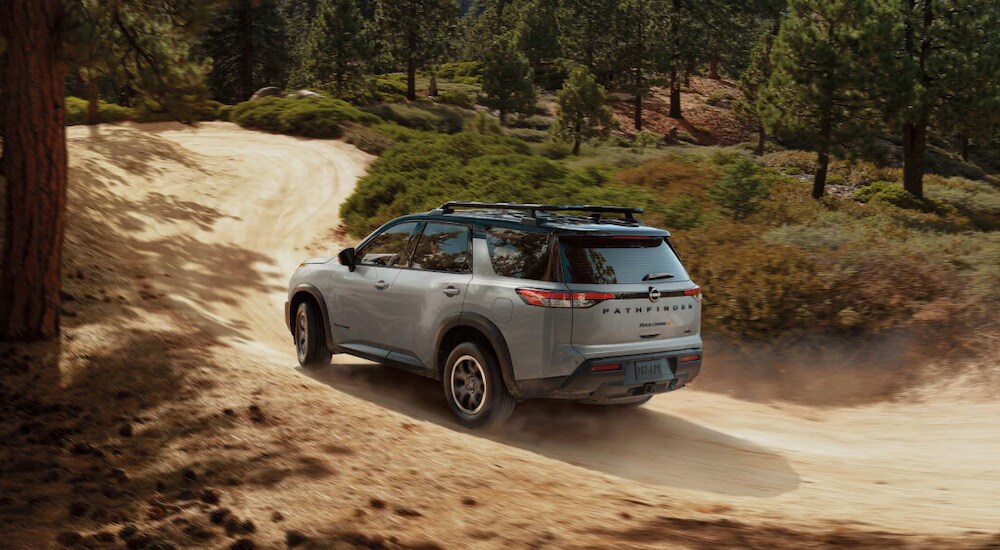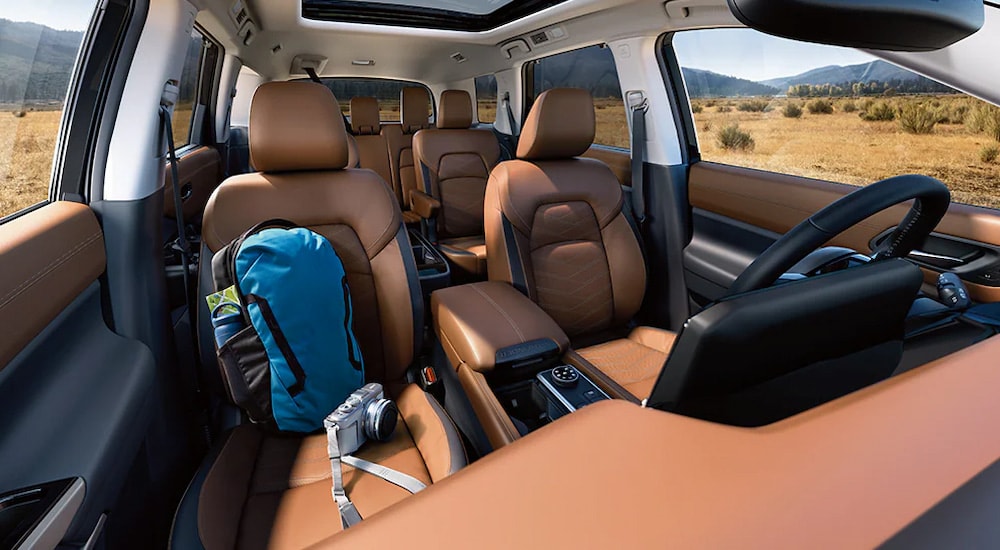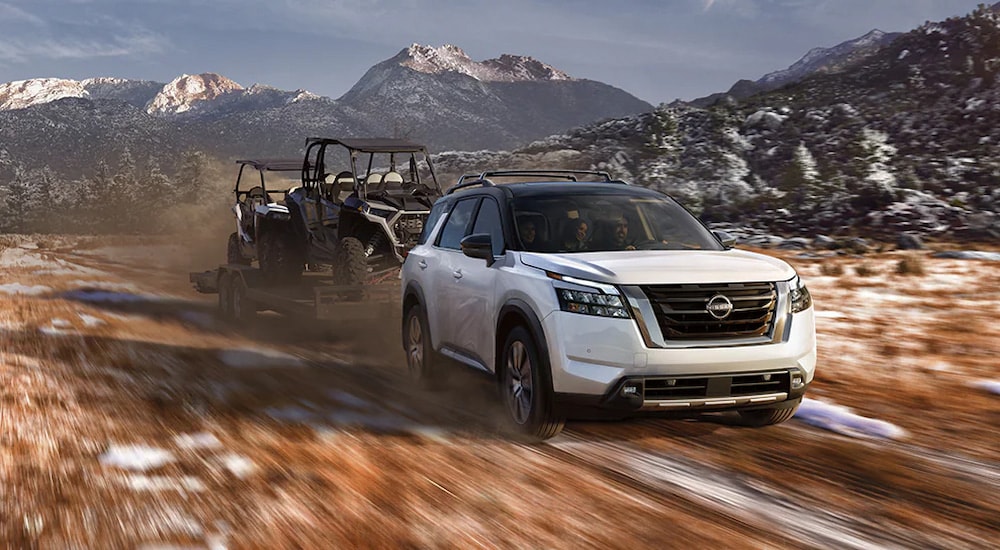The Evolution of the Nissan Pathfinder

Chances are good that if you're searching for a Nissan dealer near Wapakoneta, you might be considering the latest model of the storied Pathfinder SUV-a popular and affordable nameplate with nearly 40 years of history behind it. Even today, the Nissan Pathfinder enjoys significant popularity among families seeking a midsize SUV with plenty of room and a bevy of safety and tech features to meet their daily travel needs. It doesn't hurt that it also offers modest off-roading capability for weekend adventures at the beach or forays into the woods for a bit of hiking and camping. You know the present; now, let's take a look at the past.
The Origin Story
The first generation of the Nissan Pathfinder debuted in 1986 as a market challenge to similar offerings from American automakers. Of course, the body styling was very different back then! The original Pathfinder shared the same aggressive styling as the Hardbody pickup truck, with the same body-on-frame build, giving you the choice between a 2.4-liter 4-cylinder and a 3.0-liter V6 for some fun and sporty performance.
It was very common at the time for pickup trucks to feature aftermarket camping shells, so Nissan eliminated the extra step from the process and offered seating for up to five passengers in a two-door package, which made it a lot easier to take the whole family out on the open road for adventure! The 1990 model year of the first gen added two additional doors for better access to the rear seating and sleek, hidden C-pillar-mounted rear door handles.
Evolving Into a Classic SUV
In 1996, Nissan decided to switch the Pathfinder to a unibody platform for more aerodynamic styling to help it stand out from the Nissan pickup models of that era. Of course, this also provided more room for the 3.3-liter engine displacement, increasing the Pathfinder's performance to 168 horses. Additionally, the updated body improved handling and overall ride comfort, which were huge priorities that paid off in strong sales.
It wasn't until the 2001 model year that Nissan switched the Pathfinder over to the 3.5-liter V6 from the VQ-series engine family. This produced up to 250 hp with a five-speed manual transmission for better acceleration and more responsive driving on rural and suburban roads. Best of all, the updated instrument panel, with a navigation system and three-dimensional "Birdview" display, provided consumers with a cockpit-like atmosphere that was unlike its midsize competitors.

Third Gen's the Charm
The 2005 model Nissan Pathfinder found its construction returning to a body-on-frame design, utilizing a modified version of the F-Alpha platform that was created for the Titan full-size truck and the Armada full-size SUV. The new bigger and chunkier body styling hearkened back to the Pathfinder's truck roots while still offering the comfort and utility of an SUV. Nissan also added a split fold-down 3rd row seat to increase the Pathfinder's seating capability to seven passengers for the first time.
On top of the updated appearance, the third generation also integrated a larger 4.0-liter V6 engine that offered 266 hp and 288 lb-ft of torque to offer more speed and towing capability. However, Nissan didn't want to rest on its laurels. In 2008, the Pathfinder borrowed the larger Armada's 310 hp 5.6-liter V8 to produce 388 lb-ft of torque. With this updated engine option, a properly equipped Pathfinder could tow up to 7000 lbs which allowed owners to bring along a small horse trailer or a midsized travel trailer on their adventures.
The Fourth Generation Builds Upon Its Strong Foundation
Buyers in 2013 hungered for more efficiency in every facet of their lives, and Nissan delivered with the fourth-generation Pathfinder. This model year updated the drivetrain with a 240-horsepower 3.5-liter DOHC V6 engine and the new Xtronic transmission, a pairing that increased fuel economy to up to 27 MPG highway.
An expertly engineered and updated unibody design provided a flat floor for interior flexibility and additional space, increasing the interior roominess by 8.4 cu.ft. over the previous-generation design. Unfortunately for traditionalists, this generation abandoned the iconic hidden rear door handles on the C pillar.
The 4th-gen Pathfinder further capitalized on the unibody design's added space to innovate. One of those innovations was the new EZ Flex Seating System. This provided 5.5 inches of second-row seat motion, which allowed for easier entry and exit from the third row. In addition, the new-to-Pathfinder 2nd row 60/40-split seating featured new LATCH AND GLIDE technology, allowing access to the third row while allowing a child safety seat to remain in place.
That's not all. With the optional intuitive 4WD and standard 5000-lb towing capacity, this fourth-generation-ration Pathfinder allowed owners to easily bring ATVs, jet ski pontoon boats, and boats to their favorite recreation areas. The drive to the park could be just as enjoyable as the destination with the updated infotainment package that optionally offered an 8-inch color touchscreen monitor and a Bluetooth-enabled Bose Premium Audio System.
In the 2017 model year, the 4th-gen Pathfinder got a facelift. New fascia with restyled LED headlamps, updated tail lights, and new colors. The drivetrain also got a glow-up with a new direct-injected V6 engine that could output 284 hp and 259 lb-ft of torque. On the inside, Nissan decided the Pathfinder needed some redesigned cup holders. Nissan certainly didn't slack for the 30th anniversary of this nameplate, even without an anniversary special edition model.

The Latest Generation is Its Best Yet
Nissan took a year off Pathfinder production in the 2021 model year for their engineers to take up the task of redesigning and reformulating the Pathfinder for modern needs and competitive leverage. Interestingly, the 2022 model year Nissan Pathfinder remained a unibody crossover on the same platform as the previous generation. However, that's where the similarities end.
The vanguard of the fifth-generation Pathfinder modernized its look with sharper lines and chiseled fascia complemented by the new LED headlamps. Power body-color outside mirrors with LED turn signal indicators were standard on all trim packages. The redesigned rear end also featured rear privacy glass over the updated LED tail lights. Premium aluminum-alloy wheels accented the aggressive grille design, providing sleek visual unity.
The interior also received a major update, featuring a new seven-inch digital gauge cluster next to a nine-inch touchscreen infotainment system in addition to a helpful and unobtrusive HUD projected on the windshield. Tri-Zone Automatic Temperature Control was introduced to keep all the passengers comfortable, while the voice recognition provided safe access to Apple CarPlay and Android Auto features. The updated safety package with Front Pedestrian Detection and Automatic Emergency Braking, Active Lane Keep Assist, and Rear Collision System kept the whole family safe in a package that featured plenty of airbags to protect everyone if the worst should happen.
Nissan continues to innovate and build on this classic nameplate each year, with a focus on comfort, safety, convenience, and durability. The fifth generation's latest addition, the 2025 Nissan Pathfinder, pushes the limits of Nissan's development team, integrating newer technology while vitalizing the legacy with better performance and fuel efficiency.
The Journey Continues…
The enduring popularity of the Pathfinder has remained steady for over four decades. With a past that popular, there's no way the future can be anything but bright. It's exciting for fans of the nameplate to wonder what will come next. Nissan has stood for innovation from the outset and will continue to do so. While it would take a crystal ball to know the particulars, it's safe to say that the next generation will continue to build on the Pathfinder's legacy of technological advances, quality craftsmanship, superior safety features, and an SUV that makes you look forward to getting behind the wheel.
 AdChoices
AdChoices